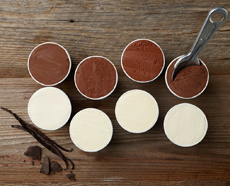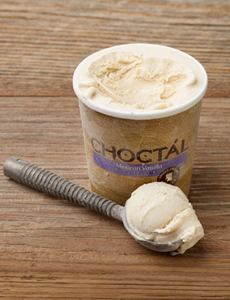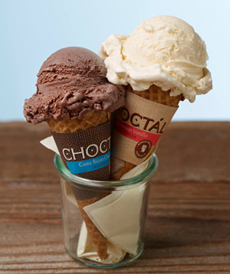TOP PICK OF THE WEEK: Choctál’s Singe Origin Ice Cream
| When we first reviewed Choctál ice cream in 2007, it was a unique experience. It still is.
The California company pioneered single origin ice cream in the two most popular flavors, chocolate and vanilla. The line—four single origin chocolate ice creams and four single origin vanillas—demonstrate how the flavor varies, based on the origin of the cacao and vanilla beans. This means you can have one heck of an ice cream tasting for National Ice Cream Month (July). It’s a memorable experience, especially for people who enjoy discerning the different flavor profiles between one origin and another in chocolate bars, olive oils, sea salts, wine grapes and so forth. The flavors of these agricultural products and others are greatly affected by their growing environment (terroir). A BRIEF HISTORY OF CHOCOLATE In the beginning—some 4,000 years ago—there was ice cream. Here’s the history of ice cream. Fast-forward ahead a few thousand years—beyond the labor-intensive ice cream made by servants of the wealthy in pre-electricity Renaissance days, beyond the invention of the ice cream churn in 1851, beyond the soda fountains at neighborhood drug scores, which engendered the ice cream soda along with scooped ice cream to eat at the fountain or to take home. Along with home refrigerators, supermarket brands arrived in the 1950s. Many used cheaper ingredients and whipped more air into then ice cream (known as overrun) to keep gallon prices low. This engendered a USDA classification system. “Economy,” “regular” and “premium” ice creams were defined by butterfat content and overrun. Häagen-Daz arrived in the 1970s with even higher butterfat and lower overrun than premium ice cream, inaugurating the superpremium category. With butterfat greater than 14% (some brands have 18% and more), overrun as low as 20% and complex flavors in addition to the basic ones), there’s no rung higher to go on the classification scale—by government standards, at least. Some companies—including Choctál—have labeled their ice cream “ultrapremium,” but this is marketing rather than an official government standard. And now, there’s single origin ice cream. WHAT IS “SINGLE-ORIGIN?” The term is not currently regulated in the U.S., but single origin can refer either to a single region or at the micro level, to a single farm or estate within that region. It is based on the agricultural concept of terroir (tur-WAH), a French term that is the basis for its the A.O.C. system (Appellation d’Origine Contrôlée, or controlled designation of origin), created in the 1950s. |
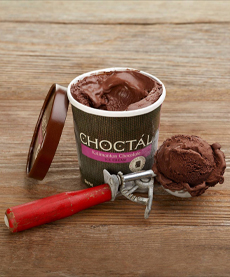
[1] A pint of Kalimantan chocolate, with beans from Borneo. [2] The four origins of chocolate and vanilla may look the same, but the tastes are noticeably different. [3] A pint of vanilla made with beans from Madagascar, the classic raised to the heights by Choctál (photos courtesy Choctál). |
|
| These environmental characteristics gives agricultural products their character. A.O.C. and related terms like Italy’s P.D.O. (Denominazione di Origine Protetta, or Protected Designation of Origin.) recognize that different plots of land produce different flavors from the same rootstock. In the 1990s, the European Union created a new system to provide a uniform labeling protocol: Protected Designation of Origin (PDO) and Protected Geographical Indication (PGI).What IS “TERROIR?”Terroir, pronounced tur-WAH is a French agricultural term that is the basis of the French A.O.C. (Appellation d’Origine Contrôlée) system. It refers to the unique components of the place (environment) where an agricultural product is grown.
Each specific habitat (plot of land) has unique set of environmental factors that affect a crop’s qualities, down to nuances of aroma, flavor and texture. They include the climate and microclimate, weather (the season’s growing conditions), elevation height and slant of the land), proximity to a body of water, slant of the land, soil type and amount of direct sunlight. This means that the same rootstock that is grown in different locations produces different flavors. Not only will the product taste and smell somewhat different (Sauvignon Blanc can have grass or grapefruit aroma and flavor notes—or neither—depending on their terroir), but intermediate products also create a difference. For example, grass with more clover, wild herbs, and so forth produces a delicate difference in an animal’s milk, and thus in artisan cheese. Note that processing will also affect the flavor. Neighboring wine makers, for example, can use different techniques to create wines that highlight their personal flavor preferences. |
||
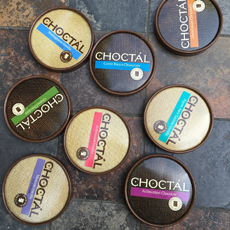
Choctàl pints and cones (photos courtesy Choctàl). |
THE CHOCTÀL SINGLE ORIGIN ICE CREAMS
Choctàl Single Origin Chocolate Ice Cream
Choctàl Single Origin Vanilla Ice Cream
The line is certified kosher by OU. While the main experience is to taste and compared the different origins to each other, they are also splendid in everything from à la mode to floats. |
|
| WHERE TO FIND CHOCTÁL ICE CREAMHere’s a store locator to find the nearest pint of Choctàl.You can also order pints and gift cards on the Choctàl website.
|
||
